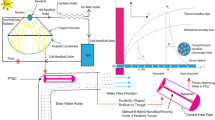Abstract
In this paper, the condensation and evaporation capacity, turbine work, efficiency, and main component size of the Ocean Thermal Energy Conversion (OTEC) power system with a liquid–vapor ejector are presented to offer the basic design data for the operating parameters of the system. The analysis procedure was performed with a simulation program called Aspentech HYSYS. The working fluid used in this system is the R32/R152a mixture. The operating parameters considered in this study include the vapor quality at the reheat outlet, the pressure ratio of the ejector, the inlet pressure of turbine 2, entrainment ratio of the liquid–vapor ejector etc. The main results are summarized as follows. The efficiency of the OTEC power cycle is closely related to the entrainment ratio of the liquid–vapor ejector. Also, the increase rate of the efficiency of proposed OTEC power cycle using the liquid–vapor ejector is 16 % higher than that of basic OTEC power cycle. Furthermore, regarding the reduction ratios of the system size that affects the initial cost, the reduction ratios of the evaporator size and the condenser size are about 13 and 14 % higher than those of basic OTEC power cycle, respectively. And, the pump power and the mass flow rate of the required refrigerant are 8 and 4 %, respectively. Therefore, the proposed OTEC power cycle is more advantageous than basic OTEC power cycle because of the compactness and high-efficiency of the system.













Similar content being viewed by others
Abbreviations
- a:
-
Attraction parameter (–)
- b:
-
Repulsion parameter (–)
- BOTEC:
-
Basic OTEC power cycle (–)
- EOTEC:
-
OTEC power cycle applying a liquid–vapor ejector (–)
- h:
-
Enthalpy (kJ/h)
- P:
-
Pressure (kPa)
- Q:
-
Capacity (kW)
- R:
-
Universal gas constant (–)
- T:
-
Temperature (°C, K)
- V:
-
Volume (m3)
- W:
-
Power output (kW)
- α:
-
Parameter of Eq. (4)
- ω:
-
Acentric factor of the species (–)
- η:
-
Efficiency (%)
- σ:
-
Entrainment ratio (–)
- C:
-
Condensation
- cr:
-
Critical point
- d:
-
Discharge
- e:
-
Evaporation
- i:
-
Inlet
- m:
-
Motive
- net:
-
Net power
- p:
-
Pump
- r:
-
Ratio
- s:
-
Suction
- sw:
-
Surface seawater
- t:
-
Turbine
References
Yoon JI, Baek SM, Son CH (2012) Power system for Ocean thermal energy conversion. Korean Soc Mar Eng 36:217–223
Yoon JI, Son CH, Baek SM, Ye BH, Kim HJ, Lee HS (2014) Performance characteristics of a high-efficiency R717 OTEC power cycle. Appl Therm Eng 72:304–308
Vega LA (2002) Ocean thermal energy conversion primer. Mar Technol Soc J 6:25–35
Uehara H, Miyara A, Ikegami Y, Nakaoka T (1996) Performance analysis of an OTEC plant and a desalination plant using an integrated hybrid cycle. J Sol Energy Eng 118:115–122
Uehara H, Dilao CO, Nakaoka T (1988) Conceptual design of Ocean Thermal energy conversion power plants in the Philippines. Sol Energy 41:431–441
Kim NJ, Ng KC, Chun W (2009) Using the condenser effluent from a nuclear power plant for Ocean thermal energy conversion (OTEC). Int Commun Heat Mass Transf 36:1008–1013
Li X, Zhao C, Hu X (2012) Thermodynamic analysis of the organic rankine cycle with an ejector. Energy 42:342–349
Li X, Zhang Q, Li X (2013) A Kalina cycle with an ejector. Energy 54:212–219
Xu RJ, He YL (2011) A vapor-injector-based novel regenerative organic rankine cycle. Appl Therm Eng 31:1238–1243
Papadopoulos A, Stijepovic M, Linke P (2010) On the systematic design and selection of optimal working fluids for organic rankine cycles. Appl Therm Eng 30:760–769
Yoon JI, Son CH, Baek SM, Kim HJ, Lee HS (2014) Efficiency comparison of a subcritical OTEC power cycle using various working fluids. Heat Mass Transf 50:985–996
Shengjun Z, Huaixin W, Tao G (2011) Performance comparison and parametric optimization of the subcritical organic rankine cycle (ORC) and the transcritical power cycle system for low-temperature geothermal power generation. Appl Energy 88:2740–2754
Uehara H (1999) Experimental research on Ocean thermal energy conversion using the Uehara cycle. In: International OTEC/DOWA conference, Imari, Japan, 28 Oct–2 Nov, pp 132–141
Noda N, Ikegami Y, Uehara H (2002) Extraction condition of OTEC using the Uehara cycle. In: International offshore and polar engineering conference, pp 631–634
Peng DY, Robinson DB (1976) A new two-constant equation of state. Ind Eng Chem Fundam 15:59–64
ASHRAE handbook (2009) Fundamentals. ASHRAE research, chapter 29, pp 2–4
HYSYS V_8.0, Aspentech, Inc.
Acknowledgments
This work was financially supported by the R&D project of “Development of Desalination Plant using Ocean Thermal Energy” supported by the Korea Research Institute of Ships and Ocean Engineering.
Author information
Authors and Affiliations
Corresponding author
Rights and permissions
About this article
Cite this article
Yoon, JI., Son, CH., Seol, Sh. et al. Performance analysis of OTEC power cycle with a liquid–vapor ejector using R32/R152a. Heat Mass Transfer 51, 1597–1605 (2015). https://doi.org/10.1007/s00231-015-1526-2
Received:
Accepted:
Published:
Issue Date:
DOI: https://doi.org/10.1007/s00231-015-1526-2




